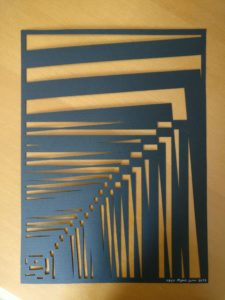Born as an almost automatic response to an urge to draw, to keep his artistic flow going even while at work, the Papercuts series became a carefully calibrated exploration of optical aesthetics and the first official steps Mattia Cuttini made towards his career in crypto art. Yet, as its title suggests, this seminal series has its roots in its physical, paper-made version, so let’s deep dive into the Papercuts’ genesis.
It was back in 2016 when Cuttini started taking the first notes around the concept at the basis of the Papercuts. Squared notebooks were his inseparable companions while he was working as a graphic designer. The squared pages provided him with a constructive grid, a fixed reference within which he could jot down visual clues and reflections or actual drawings. At the time, while attending a course on how to create a font, he got closer to the optical aesthetic often admired as a boy in the works of Gruppo T and others. Cubes, prisms, black and white mazes, and traces of the famous logotype with which he now signs his works began to appear in Cuttini’s notebooks. Accompanying him during these graphic explorations in his free time was also his son Mirko, involved by the often playful nature of his father’s seemingly methodical experiments.

Cuttini’s deep connection with printing techniques and a conversation with his friend Steve Nardini soon inspired the idea of attaching a blade to a plotter and using it as a machine to pierce and cut paper sheets. With this vision in mind, he began to sketch the first Papercuts on paper, in the shape of two squares side by side where various lines would intersect to create full areas and voids to be cut. From the first, hand-drawn prototypes, Cuttini immediately imagined a digital version of the project and started working on the analog algorithm to create other variations of the initial design. Yet, experimenting with the plotter as a cutting machine, he found out it would often tear the paper sheets. An alternative solution was needed.

Cuttini then began to use the co-working space Lino’s and Co in Udine, his current headquarters, where there was also a laser cutting machine. In January 2017, Kickstarter encouraged its community to create a series of 100 works through crowdfunding. Chance – or perhaps fate – was offering a subtle hint to a man who knows how to seize them, and Make 100 became the framework for the actual development of Cuttini’s series on laser-cut paper. Interestingly, Sparrow Read – aka Blackbox.art – also participated in Make 100, unawarely parallel to Mattia who she would later meet and support in the NFT realms.


The new era of Papercuts
The Papercuts project is significant also as it became Cuttini’s first test of crowdfunding mechanisms, co-working collaboration and community support. This is because through Kickstarter he managed to create a small but devoted group of supporters of his work, a sort of first community of known and unknown people, local and international, in view of his future entry into the crypto art community.

After various tests, in the Spring of 2017, the series began to actually appear in Lino’s and Co’s workshop, at a slow pace of 4 pieces per day. Each artwork features two groups of multiple, concentric squares chasing each other in space. In order to be laser cut, the works were first generated using Illustrator starting from the paper prototypes and an algorithm in Cuttini’s head. This analog algorithm – a forerunner of recent generative art outcomes in his practice – involves duplicating the first work and reproducing it with systematic alterations in the coordinates of each grid of concentric squares. Translation, rotation and overlapping of the same grids are thus the basis for the variations.
Each work is like a single frame, a crystalized instant taken from the potentially inexhaustible movement of the grids of squares in space. The optical effect characteristic of the series is achieved using Illustrator’s XOR control, with the black areas on screen representing the black paper and the white ones becoming the void areas in the physical, laser-cut work.
In June 2017, the paper series was completed and Cuttini held a party to celebrate the project’s birthday with all the supporters who could attend. Of the 100 physical artworks created, about 30 got mysteriously lost while 20 turned out to be duplicates due to some printing errors, for a total of 90 versions. The digital series mirrors the physical one, and the “duplicates” became special versions, reversed ones, so to speak.
First laser-cut test drive piece
“Time goes by, in 2018 Cuttini had his first solo exhibition of Rubberstamps at Kobo Shop, in Udine, most of the Papercuts’ physical copies had been sold, while the digital material remained secured in the artist’s hard disk. In the meantime, SuperRare, KnownOrigin and other crypto art galleries appeared. Drawn by curiosity, Cuttini soon approached the crypto art discourse and in the first NFT galleries’ chats, particularly in KnownOrigin’s, he shared his Papercuts. Ilan Katin’s keen eye noticed the works and suggested an exchange with his own, so the physical pieces began to circulate in this new community. After the crowdfunding campaign, with this series Cuttini seeked and found in the crypto art realms that same context, made of sincere connections between people and artists at a human and not only professional level.
In December 2019, Cuttini finally decided to tokenize the series, and chose to use pixura. Just as he was about to proceed, however, his laptop broke. His economic situation prevented him from replacing it immediately, but he did not abandon the idea. Little by little, like a digital craftsman, Cuttini found himself using a makeshift tablet to convert the pdf pages of a small self-produced publication on the project into png files, digitizing the series one piece after another.”
Eventually, the Papercuts appeared in the digital world through the Mattia Cuttini Produkt smart contract
Source: https://en.cryptonomist.ch/2022/12/11/papercuts-genesis/

